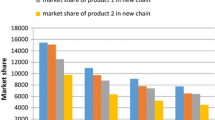Abstract
This paper is concerned with the algorithm of the supply chain network equilibrium model and its equivalent supernetwork based traffic network equilibrium model with elastic demands. Both models are further written as nonlinear complementarity problems. Semismooth least squares reformulations of the complementarity problems are presented and their convergence properties are investigated. Considering the drawbacks of Quasi-Newton method (using the Fischer-Burmeister function), a semi-smooth Levenberg-Marquardt-type method is proposed to solve the problems. Numerical examples show that the Levenberg-Marquardt-type method can solve the supply chain network equilibrium model and its equivalent supernetwork based traffic network equilibrium model significantly, and is more efficient than the Quasi Newton method and the modified projection method. Furthermore, the Levenberg-Marquardt-type method with the equivalent supernetwork based complementarity formulation can be implemented faster than with the supply chain network equilibrium complementarity formulation.
Similar content being viewed by others
References
Erenguc S S, Simpson N C, Vakharia A J. Integrated production/distribution planning in supply chains: An invited review. Euro J Opera Res, 1999, 115: 219–236
Nagurney A, Dong J, Zhang D. A supply chain network equilibrium model. Transport Res E, 2002, 38: 281–303
Dong J, Zhang D, Nagurney A. A supply chain network equilibrium model with random demands. Euro J Opera Res, 2004, 156: 194–212
Nagurney A, Matsypura D. A supply chain network perspective for electric power generation, supply, transmission, and consumption. In: Proceedings of the International Conference in Computing, Communications and Control Technologies, vol. VI. Austin: Texas, 2004. 127–134
Nagurney A, Toyasaki F. Reverse supply chain management and electronic waste recycling: A multitiered network equilibrium framework for e-cycling. Transport Res E, 2005, 41: 1–28
Zhang D. A network economic model for supply chain versus supply chain competition. Omega, 2006, 34: 283–295
Wu K, Nagurney A, Liu Z, et al. Modeling generator power plant portfolios and pollution taxes in electric power supply chain networks: A traffic network equilibrium transformation. Transport Res D, 2006, 11: 171–190
Çanakoğlu E, Bilgiç T. Analysis of a two-stage telecommunication supply chain with technology dependent demand. Euro J Opera Res, 2007, 177: 995–1012
Hammond D, Beullens P. Closed-loop supply chain network equilibrium under legislation. Euro J Opera Res, 2007, 183: 895–908
Nagurney A, Liu Z, Cojocaru M, et al. Dynamic electric power supply chains and transportation networks: An evolutionary variational inequality formulation. Transport Res E, 2007, 43: 624–646
Cruz J. Dynamics of supply chain networks with corporate social responsibility through integrated environmental decision-making. Euro J Opera Res, 2008, 184: 1005–1031
Hsueh C, Chang M. Equilibrium analysis and corporate social responsibility for supply chain integration. Euro J Opera Res, 2008, 190: 116–129
Nagurney A. On the relationship between supply chain and transportation network equilibria: A supernetwork equivalence with computations. Transport Res E, 2006, 42: 292–316
Si B F, Zhong M, Sun H J, et al. Equilibrium model and algorithm of urban transit assignment based on augmented network. Sci China Ser E-Tech Sci, 2009, 52(11): 3158–3167
Wu J J, Gao Z Y, Sun H J. Topological-based bottleneck analysis and improvement strategies for traffic networks. Sci China Ser E-Tech Sci, 2009, 52(10): 2814–2822
Meng Q, Huang Y K, Cheu R L. A note on supply chain network equilibrium models. Transport Res E, 2007, 43: 60–71
Chiou S W. A non-smooth optimization model for a two-tiered supply chain network. Information Sci, 2007, 24: 5754–5762
Kanzow C, Petra S. Projected filter trust region methods for a semismooth least squares formulation of mixed complementarity problems. Opti Meth Soft, 2007, 22: 713–735
Dafermos S, Nagurney A. Stability and sensitivity analysis for the general network equilibrium-travel choice model. In: Volmuller, J., Hamerslag, R. (Eds.), Proceedings of the Ninth International Symposium on Transportation and Traffic Theory. Utrecht, Netherlands: VNU Science Press, 1984. 217–232
Nagurney A. Network Economics: A Variational Inequality Approach. Revised Second ed. Dordrecht: Kluwer Academic Publishers, 1999
Chen B, Chen X, Kanzow C. A penalized Fischer-Burmeister NCP-function. Math Program, 2000, 88: 211–216
Kanzow C, Petra S. On a semismooth least squares formulation of complementarity problems with gap reduction. Opt Meth Soft, 2004, 19: 507–525
Fischer A. A special Newton-type optimization method. Opti, 1992, 24: 269–284
Fischer A. Solution of monotone complementarity problems with locally Lipschitzian function. Math Program, 1997, 76: 513–532
Geiger C, Kanzow C. On the resolution of monotone complementarity problems. Comp Opti Appl, 1996, 5: 155–173
Qi L, Sun D. A survey of some nonsmooth equations and smoothing Newton methods. In: Eberhard A, et al. eds. Progress in Optimization. Dordrecht: Kluwer Academic Publisher, 1990. 121–146
Robinson M. Strongly regular generalized equations. Math Opera Res, 1980, 5: 43–62
Author information
Authors and Affiliations
Corresponding author
Rights and permissions
About this article
Cite this article
Xu, M., Gao, Z. An efficient algorithm for solving supply chain network equilibria and equivalent supernetwork based traffic network equilibria. Sci. China Technol. Sci. 53, 3264–3274 (2010). https://doi.org/10.1007/s11431-010-4168-0
Received:
Accepted:
Published:
Issue Date:
DOI: https://doi.org/10.1007/s11431-010-4168-0



